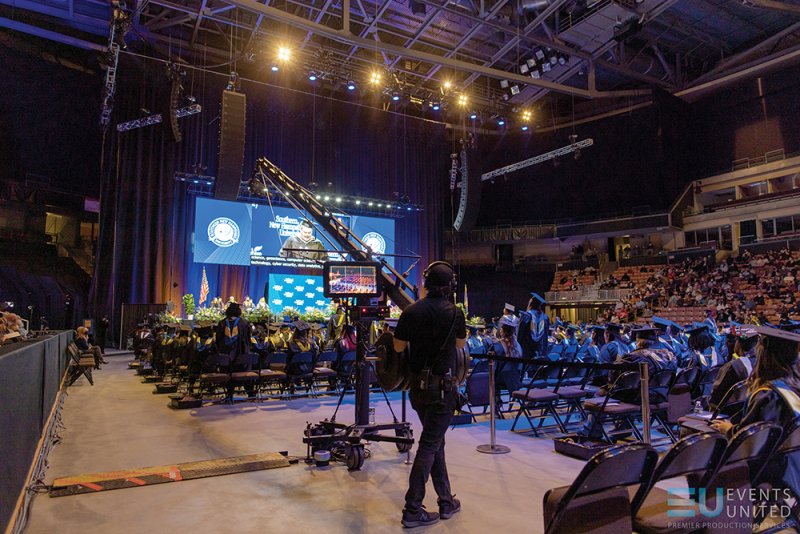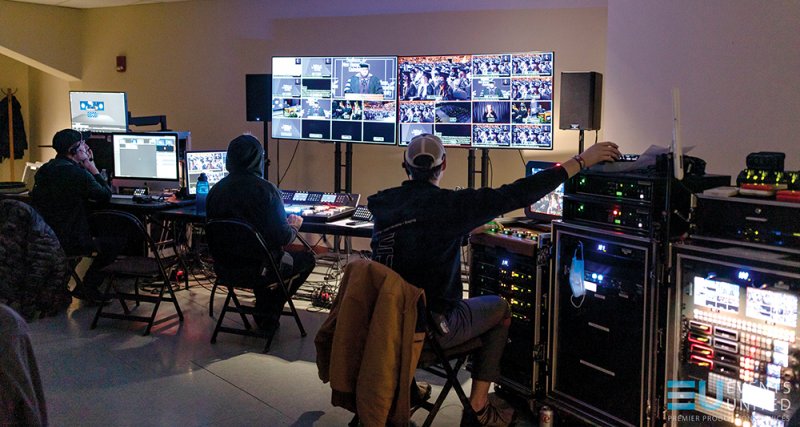 Malloy Event’s hybrid set up in Manchester during a biotech event in the fall of 2021. (Courtesy of Malloy Events.)
Malloy Event’s hybrid set up in Manchester during a biotech event in the fall of 2021. (Courtesy of Malloy Events.)
When the pandemic started, events moved online, with presenters broadcasting from a Zoom meeting or webcast to a remote audience. Now nearly two years into the pandemic and with vaccinations available, people have become more comfortable gathering in public—some even craving the in-person interaction. But as COVID cases continue to climb in NH, others remain wary.
As such, many organizations are continuing to toy with hybrid events, in which some of the participants are, to quote the musical Hamilton, in “the room where it happens,” while others chime in remotely.
“I see the hybrid as being a part of many events in the future,” says Chris Malloy, president and event producer with Malloy Events in Rochester. “You can look at it as a liability but if you do, you’re not going to get much good out of it. Some clients are able to reach a much larger geographic audience than they would have, or for some nonprofits, they are able to reach people they wouldn’t have otherwise reached, or for a keynote speaker, you can present to people who otherwise would not be there.”
The challenge has been creating an engaging experience by enabling those remote participants to hear and see the event as well as those present, while being able to fully participate. As anyone who’s tried it can attest, it’s not easy.
“There’s a way, but with that said, people go to college for this,” says Tim Messina, owner of Events United, an event production company in Derry. “The easiest thing is to take a laptop out, put it at the head table, just call it a Zoom meeting and hope people can hear. Well, they aren’t going to be able to hear or see well and ultimately are going to leave because it’s so bad. So, you’re not going to have an online audience at all.”
Size up Your Options
The simplest answer to hosting a successful hybrid meeting is to hire a professional event production company. While that may be practical for a major fundraiser, where the increase in money raised by expanded participation will offset the cost of production, or a big annual event for a large corporation with a sizable budget, it may not be a viable for a social organization or business networking group that meets weekly or a small business with a budget to match.
Event organizers need to take stock of how vital the remote portion is to the overall success of the event and invest accordingly. Is the remote audience a small or large portion of overall attendees? Is the event a one-time extravaganza or a routine weekly meeting? What is the need for real-time interaction between those present and those online?
“Applying the right process to the right organization is important,” says Malloy. “If a company is hosting a conference and wants to bring employees from all over the country or all over the world, all of the sudden it’s a lot easier to schedule, a lot cheaper and a lot safer than flying them in; and it protects against the uncertainty. It’s a nice hedge against things that could come up.”
A hybrid conference that attracts a large group from far-flung locations would likely involve professional event hosting, but what about the do-it-yourselfers? The best advice from the pros is to keep it as simple as possible. Focus on capturing good audio and make sure remote participants can see and be seen. “The audio for some of these meetings is more important than the video,” says Messina.
Tools of the Trade
Messina recommends purchasing a device known as an encoder that can accept both video and audio inputs, so the event organizer can use a real microphone in place of the laptop mic and a hand-held or tripod-mounted high-def video camera in place of the laptop camera. The Blackmagic Web Presenter, a hardware encoder with software for connecting to streaming platforms and network connections, is one example.
“You have to mic your presenter at a minimum, and that microphone is going to feed into an encoder,” says Messina. “Let’s say that you need to move around and don’t want to use the camera on your computer, you could use a different camera.
Some people like a simple camcorder with good zoom. You can send that feed right into the web presenter. Now you have a camera and your audio feed coming in, and you can select and zoom through the web presenter.”
Cost for a web presenter runs around $500, while a microphone (wired or wireless) can be purchased for around $100. The most popular is a Shure SM58, with a cable that plugs into the web presenter. For occasions where different people need to take turns speaking, the meeting will need a mic stand with speakers taking turns.
Malloy also urges special attention to the lighting in the room. “When doing live events, there almost has to be an overwhelming amount of light because you can’t control people’s screens at home. If their brightness is down, we have to compensate for that at our end.”
“There’s no way around it,” says Malloy. “You need stuff and people to operate the stuff.”


Southern NH University’s hybrid graduation ceremony, produced by Events United. (Lauren Lyons/Events United.)
Testing, Testing
Another fundamental is to test all the meeting components with someone zooming in as a guinea pig. Set-up the laptop and, test audio and sound from any video presentations, the lighting, the camera position and the speakers’ sound quality.
“Those things are going to make or break your event,” says Malloy. “We stress test PowerPoint presentations onsite to make sure there are no problems with video, photos, fonts … everything that can go wrong.
Malloy also says the chat function in Zoom is an effective tool to keep remote participants engaged. “You can send out a message that gives people the expectation of what’s happening next,” he says. “If a speaker references a slide, you can send a link to that; or let everyone know there’s going to be a break in 15 minutes.”
The emerging need for more hybrid meetings has created new opportunities for event hosting companies, given the complexity of doing it yourself. “We’ve had pretty explosive growth for us in this space,” says Messina.
Whether you’re a fan or not, hybrid events are part of the norm. “The biggest thing to keep in mind is that you are only going to get out of it what you put into it,” says Malloy. “There can be so many bene-fits to the hybrid meeting, as long as you do it well, treat it seriously and view it as an opportunity rather than a problem.”

 Current Issue - April 2024
Current Issue - April 2024